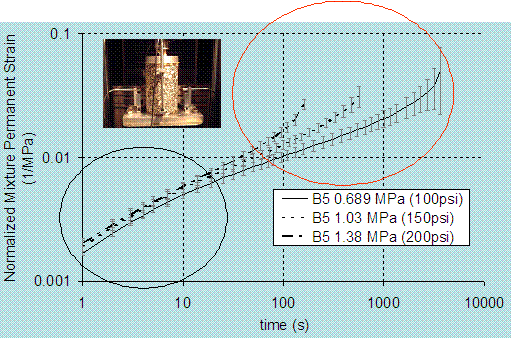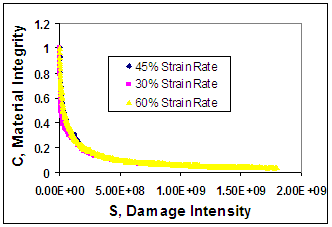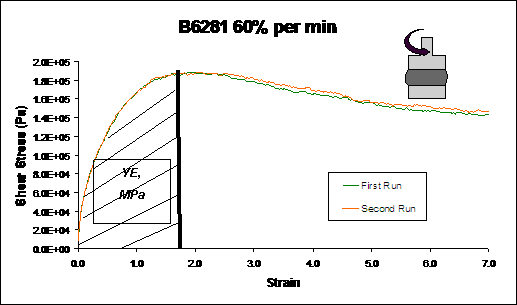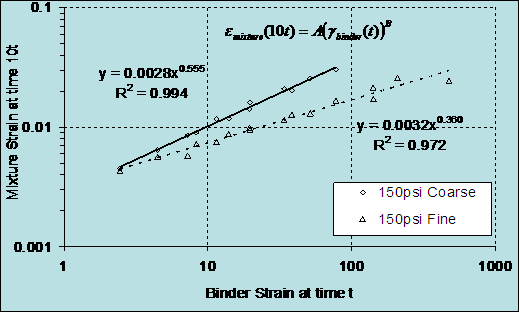|
Binder Damage Resistance Characterization: Rutting Applied stresses and loading times affect the creep behavior of asphalt binders. However, new research results from the UW research team show that, under certain combinations of stress and loading time, some binders show non-linear behavior that resembles tertiary flow in mixtures. However, even under identical testing conditions, this non-linear effect is not seen for all binders. Instead, the creep behavior and the conditions under which the tertiary-like behavior begins are found to vary significantly among binders and depend on testing geometry, stress, loading time and temperature. Beyond investigating the behavior of different binders, mixtures produced using identical binder were also studied to further investigate binder creep behavior and tertiary flow of mixtures.
Dr. Rodrigo Delgadillo’s work at UW was instrumental in the development of a model to fit the creep behavior of binders and mixtures. The model showed a strong correlation between binder creep behavior and tertiary flow seen in mixtures at various conditions of stress and loading times. Since the impact of the binder becomes more pronounced as the time of loading is increased (to the right on the graph below), it is increasingly clear that damage evolution must be studied at high stresses and loading times. These results suggest that being able to better characterize binders with varying sensitivity to stress and total loading time can improve understanding of flow number of mixtures. This in turn may help identify modifiers that increase the flow number of mixtures and provide superior resistance to rutting of pavements.
Binder Fatigue Resistance: Verification of the Relationship Between DSR Binder Fatigue Tests and Mixture Fatigue Performance The UW research team is developing a reliable test to explain the role of binders in the fatigue of mixtures and pavements. The team is using fundamental mechanics to model and predict the fatigue behaviors of asphalt binders and is following a comprehensive plan to test various fatigue models for asphalts. UW will select those models that can be implemented effectively to provide better fatigue life of pavements under various simulated conditions of traffic, climate and pavement structures. The team is developing new fatigue specification limits for asphalt binders. Current asphalt binder specifications use the parameter G*sin d to characterize binder fatigue behavior. However, previous studies—most notably NCHRP 9-10—have shown that this parameter has limitations, especially for modified asphalt. The team has found that yield energy from monotonic testing in the dynamic shear rheometer is a good fatigue test candidate and correlates well with the field performance of asphalt binders, including modified binders. Another advantage of this test is that it is fast, taking less than 30 minutes. This can be a great benefit for implementation.
UW is also employing viscoelastic continuum damage mechanics to model the behaviors of asphalt binders. This approach could capture the fundamental fatigue properties of asphalt binders and use them for mechanistic design of asphalt pavement and asphaltic mixtures that are further resistant to fatigue. ARC |
|
University of Wisconsin-Madison Takes New Approaches to the Study of High-Performance Asphalts continued |
|
Stress can affect creep compliance (J) differently for two binders. Left: Non-linear, tertiary flow is observed for PG 70-22 asphalt with binder B5. Right: Linear flow is observed for PG 64-22 asphalt with binder N3. Both were measured in the DSR using a cone-and-plate geometry. |


|
PG 70-22 asphalt mixture produced with modified binder B5 was subjected to different stress levels—it showed tertiary behavior earlier under higher stress (shown in the red circle). |
|
The binder yield energy test (BYET) in the DSR quickly and effectively measures a binder’s load capacity before yielding. These values correlate well with fatigue in the field. |

|
Fundamental fatigue properties are independent of such external conditions as loading rates, testing modes, and temperatures. |



|
To remove your name from our mailing list, please click here. Questions or comments? E-mail us at psebaaly@unr.edu or call 775-784-6565. |